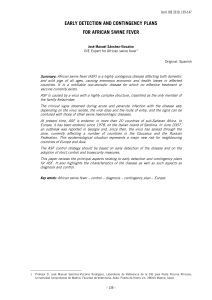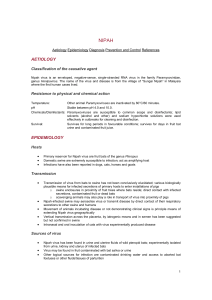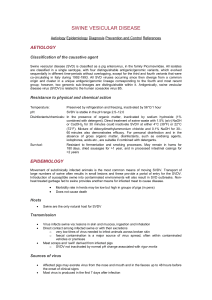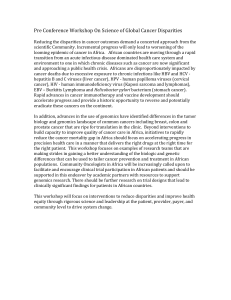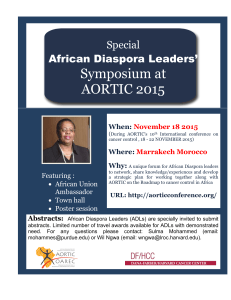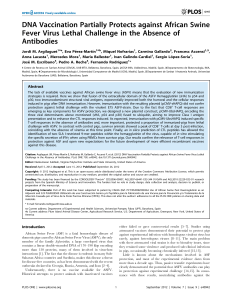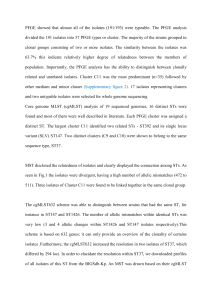D8589.PDF
publicité
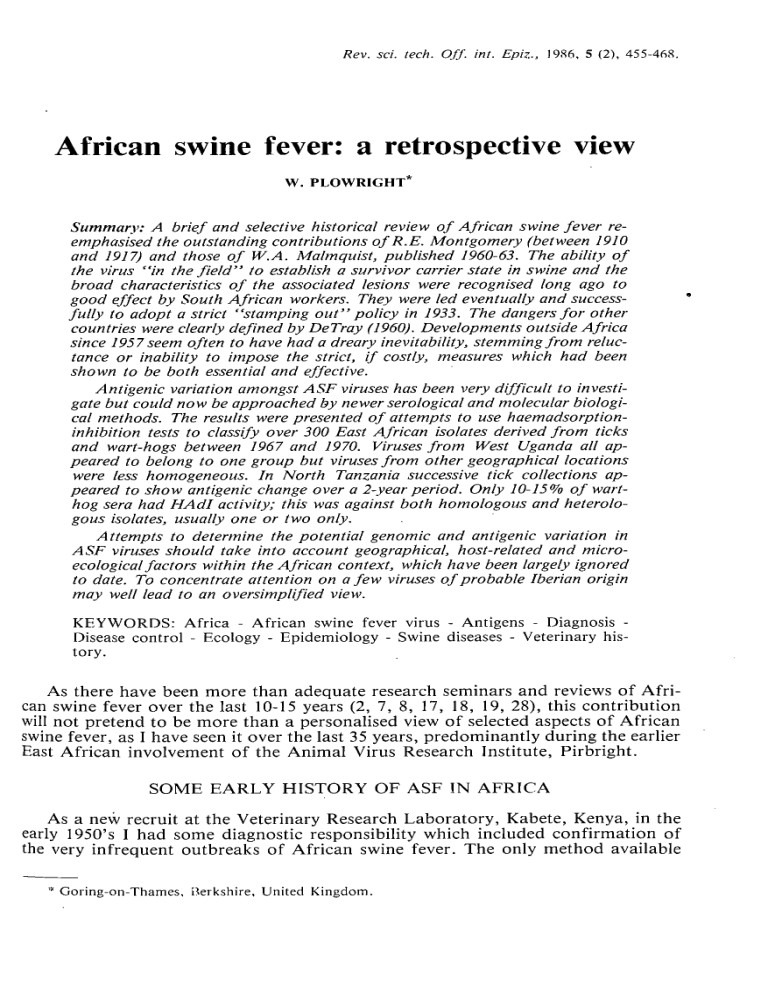
Rev. sci. tech. Off. int. Epiz., 1986, 5 (2), 455-468. African swine fever: a retrospective view W. PLOWRIGHT* Summary: A brief and selective historical review of African swine fever reemphasised the outstanding contributions of R.E. Montgomery (between 1910 and 1917) and those of W.A. Malmquist, published 1960-63. The ability of the virus "in the field" to establish a survivor carrier state in swine and the broad characteristics of the associated lesions were recognised long ago to good effect by South African workers. They were led eventually and success­ fully to adopt a strict "stamping out" policy in 1933. The dangers for other countries were clearly defined by DeTray (1960). Developments outside Africa since 1957 seem often to have had a dreary inevitability, stemming from reluc­ tance or inability to impose the strict, if costly, measures which had been shown to be both essential and effective. Antigenic variation amongst ASF viruses has been very difficult to investi­ gate but could now be approached by newer serological and molecular biologi­ cal methods. The results were presented of attempts to use haemadsorptioninhibition tests to classify over 300 East African isolates derived from ticks and wart-hogs between 1967 and 1970. Viruses from West Uganda all ap­ peared to belong to one group but viruses from other geographical locations were less homogeneous. In North Tanzania successive tick collections ap­ peared to show antigenic change over a 2-year period. Only 10-15% of warthog sera had HAdI activity; this was against both homologous and heterolo­ gous isolates, usually one or two only. Attempts to determine the potential genomic and antigenic variation in ASF viruses should take into account geographical, host-related and microecological factors within the African context, which have been largely ignored to date. To concentrate attention on a few viruses of probable Iberian origin may well lead to an oversimplified view. KEYWORDS: Africa - African swine fever virus - Antigens - Diagnosis Disease control - Ecology - Epidemiology - Swine diseases - Veterinary his­ tory. As there have been more than adequate research seminars and reviews of Afri­ can swine fever over the last 10-15 years (2, 7, 8, 17, 18, 19, 28), this contribution will not pretend to be more than a personalised view of selected aspects of African swine fever, as I have seen it over the last 35 years, predominantly during the earlier East African involvement of the Animal Virus Research Institute, Pirbright. S O M E E A R L Y H I S T O R Y O F A S F IN A F R I C A As a new recruit at the Veterinary Research Laboratory, Kabete, Kenya, in the early 1950's I had some diagnostic responsibility which included confirmation of the very infrequent outbreaks of African swine fever. The only method available * Goring-on-Thames, Berkshire, United Kingdom. — 456 — then was to inoculate pigs, and classical swine fever (hog cholera) was, fortunately, as to this day, not present in the country to confuse the issue. The "isolation faci­ l i t y " at the time was a large inverted steel tank, with a hole or " d o o r " in the side and a thick coat of rust. It was located in a paddock a short distance from other a c c o m m o d a t i o n a n d , I was assured, h a d been there since the days of R . E . Montgo­ mery. Simple changes of external clothing and disinfectant cleansing were found sufficient to confine A S F , though Montgomery (13) did record that on the 15th August, 1914, an infected pig escaped from an isolation tank and contaminated 15 clean animals, all of which died! R. Eustace M o n t g o m e r y , after whom the disease was for a time named, was appointed Veterinary Pathologist, East African Protectorate, and published his classical papers on African swine fever in 1921. However, the research on which these were based was carried out between J u n e 1910, when he first m a d e a provisio­ n a l identification, and 1917. The war of 1914-18 and then M o n t g o m e r y ' s transfer, first to South Africa and later to U g a n d a , both prevented his completion of the work and delayed publication. Tables I and II summarise what must be considered his outstanding achievements, especially taking into account the other animal disease problems to which he contributed and the relative isolation of East Africa at the time. Nevertheless, with respect to the latter, it should surely amaze Chief Vete­ rinary Officers to-day to read Sir Stewart S t o c k m a n ' s letter from London on Mont­ gomery's virus, sent to him in August, 1911. O n the 19th August, 1912 he wrote that he had inoculated a "considerable number of pigs with the virus which I have kept continuously at the laboratory and not a single one has recovered". F u r t h e r m o r e , Stockman also sent a classical swine fever virus to East Africa where Montgomery inoculated it into pigs, presumably in the "isolation t a n k s " . The fact that together they showed the absence of an immunological relationship between classical swine fever (CSF) and A S F (though Montgomery still concluded that the East African disease was a hyperacute form of CSF) might not to-day be regarded as justification for the risks taken! M o n t g o m e r y ' s findings in East Africa were soon confirmed in South Africa where Steyn (20, 21) and De Kock et al. (3) first proved that the reservoir of the virus was in wart-hogs and bushpigs from some areas. It was shown that survivor domestic swine, particularly piglets, could h a r b o u r virus up to 10 m o n t h s and transmit it as long as 7 months after an outbreak, that they developed joint swelTABLE I Epidemiological characteristics of ASF in East Africa Established by R.E. Montgomery, 1910-1922* 1. 2. 3. 4. 5. 6. 7. 8. 9. Association with wild Suidae and free-ranging pigs. Not related to movements of pigs, fomites, transport. Bushpigs resistant; develop viraemia. Wart-hogs developed pyrexia and viraemia. No "contact" transmission from wild Suidae to pigs. Transfer from reservoirs by carnivorous habits of Suidae, or vectors (?). Transmission among pigs primarily by oropharyngeal route. No transmission from swine in first 12-24 hours of pyrexia. Persistence of contagion in contaminated fomites and pigsties quantified. * J. comp. Path., (1921), 34, 159-191 a n d 243-262. Bull. N o . 2, Veterinary D e p a r t m e n t . C o l o n y a n d P r o t e c t o r a t e of Kenya, 1922. — 457 TABLE I I Properties of ASFV Established by R.E. Montgomery, 1910-1922* 1. 2. 3. 4. 5. 6. 7. Clinicopathological resemblances to and differences from swine fever (SF). Virus filtered and unrelated to SF. Great resistance of ASFV to putrefaction, heat. Survivors very rare; may be immune or partially resistant to challenge. Subacute and subclinical infections noted. No protective or neutralising activity in antisera (with Stockman). Heat-inactivated virus non-immunogenic. * J. comp. Path., (1921), 34, 159-191 a n d 243-262. Bull. N o . 2, Veterinary D e p a r t m e n t , C o l o n y a n d P r o t e c t o r a t e of Kenya. 1922. lings as well as the p u l m o n a r y , serosal and diphtheritic intestinal changes observed by Montgomery in longer survivors. Finally, it was found that a policy of complete slaughter and quarantine was necessary to eradicate the infection. T h u s , following its introduction to Cape Province in 1933, the disease was finally eradicated there in 1939 (15). I have mentioned these early studies, not because they have escaped attention in reviews but because they presaged what could often be described as the dreary ine­ vitability of subsequent epidemiological events outside Africa. In particular, sub­ acute and chronic forms of the disease, m o r e closely resembling hog cholera, were clearly described by M o n t g o m e r y onwards and were probably well-established in the field, in Angola for example (7, 8), by the late 1940's. DeTray (4) summarised the situation thus soon after the introduction of A S F to P o r t u g a l and Spain — " A l t h o u g h A S F , as we k n o w it, kills nearly 100% of infected domestic swine, it seems altogether possible that less virulent strains may develop in nature with a resulting higher survival rate and an increase in the n u m b e r of carriers. Thus the disease could become enzootic in domestic pigs in areas where wart-hogs are non­ existent. For this reason, complete stamping out of the disease is essential". It can­ not be said that regulatory authorities were not well advised! THE BEGINNING OF MODERN ASF RESEARCH The first real b r e a k t h r o u g h in A S F research after M o n t g o m e r y was m a d e by W.A. Malmquist at the end of the 1950's (11). W o r k i n g in Kenya (with D . Hay) he discovered the h a e m a d s o r p t i o n and cytopathic effects in buffy coat and bone mar­ row culture which, together with his i m p o r t a n t derivative observations listed in Table III, were the foundation on which virtually all laboratory work has been The contributions 1. 2. 3. 4. 5. 6. 7. of Winston TABLE I I I A. Malmquist* to ASF research and control Discovery of haemadsorption (HAd) and cytopathic effects in monocyte cultures. Adaptation of ASFV to cell lines (PK, OK). Production of viral antigens for immunoprecipitation and CF tests, etc. Attenuation of ASFV in cell cultures; production of antisera. Showed development of AGDP, CF, HAdl antibodies; no neutralisation. HAdl antibodies strain-specific. Protection against challenge generally strain-specific. * Amer. J. vet. Res., (1960), 21, 104-108: (1962). 23, 241-247: (1963), 24. 450-459. — 458 — based during the last 20-25 years. Diagnostic techniques, serology, studies on pathogenesis, immunology, epidemiology and molecular biology were all suddenly m a d e technically and economically feasible, where the absence of alternative hosts to the pig had previously rendered all research expensive, hazardous and narrowly constrained. It was doubly fortunate that Malmquist's discovery of haemadsorption for virus detection and assay narrowly pre-dated the first permanent establish­ ment of the virus in E u r o p e (1960). It is also remarkable that it is still an unex­ plained p h e n o m e n o n , poorly characterised and arousing little interest. Our own epidemiological studies, from 1966 to 1972, on wart-hogs and ticks in East Africa (16, 17), were m a d e possible with methods developed by Malmquist and, with relatively minor modifications, have been confirmed by recent work in southern Africa (24). ANTIGENIC A N D IMMUNOLOGICAL VARIATION IN ASF VIRUSES A more neglected field is that of antigenic variation in ASFV, especially as it relates to the natural ecology of the virus in Africa. The collection over several years of isolates of ASFV, from wart-hogs and ticks in East Africa, provided us with the basic viral materials but the methodology available was then very limited — practically restricted to haemadsorption-inhibition tests, which had first been developed and applied with some success by Malmquist. I therefore propose to review briefly the existing information on antigenic and immunological variation and to present the results obtained, with my colleagues A. Greig and W. Doughty, for several hundred East African isolates. Immunological diversity amongst strains of ASFV has been recognised for a long time; recovered pigs sometimes resisted homologous challenge and occasio­ nally even exposure to heterologous strains (4, 7 for review, 10); the " i m m u n i t y " in some cases was, however, not absolute a n d / o r enduring. Malmquist (1963) found that an attenuated 1954 wart-hog isolate (Hinde 1) failed to protect two pigs against a second wart-hog virus (Hinde 2) isolated on the same property in 1959; this sug­ gested significant immunological differences or shifts in one restricted wart-hog population. He also showed that it was haemadsorbing virus of the challenge type which predominated in the blood of pigs which were inoculated with a heterologous strain. Coggins reviewed work on the resistance of recovered, often viraemic, swine to challenge (2) but the majority of recent evidence has been obtained using viruses derived from the second Iberian invasion (Lisbon, 1960, particularly) or their probable derivatives (5, 12, 32). Repeated inoculation of one isolate (Uganda 1959) was found to broaden the range of viruses to which pigs were resistant, including Tengani (a Malawi isolate), Hinde (Kenya) and Kirawira XII (Tanzania) (6); a similar conclusion was suggested by later studies (23, 5). Unfortunately, in the virtual absence of neutralising antibodies, the only way to investigate immunological variation among A S F viruses is to challenge the immu­ nity of recovered animals; there was and is no serological correlate of resistance, in spite of early indications from Malmquist's work (10) that strains which were similar in their haemadsorption antigens did cross-protect, whilst those that dif­ fered in this respect failed to do so. It soon became obvious that recovered resistant pigs often had no scrum inhibitor of homologous or heterologous virus haemad- — 459 — sorption (1, 2, 23). F u r t h e r m o r e , in South Africa, pigs which had recovered from infection with a naturally occurring, plaque-purified and non-haemadsorbing strain of much reduced virulence from Zaire were resistant to heterologous challenge with three different haemadsorbing isolates (23). In addition, some of these resistant pigs developed haemadsorption-inhibiting (HAdI) antibodies following challenge and the haemadsorbing virus was recovered from the spleen of an animal exposed intranasally. It was concluded that haemadsorption was neither a marker of viru­ lence nor could its inhibition be used to determine significant immunological diffe­ rences (23). Antigenic variation in ASF viruses in East Africa In spite of these shortcomings, haemadsorption antigens do have the epidemio­ logical advantage of being stable over many years of virus circulation, e.g. at least 8 years in pigs in the Iberian peninsula (25, 26). Tests for haemadsorption inhibi­ tion (HAdI) are also simple and rapid to perform — a necessity if we were to get through the 300 or so virus isolates and 180 wart-hog sera available to us in 1969/70. There are obviously several other techniques which could now be applied to the elucidation of antigenic variation of A S F viruses, e.g. complementdependent antibody lysis or C D A L (14, 27); reaction with monoclonal antibodies (8) and restriction endonuclease patterns of viral D N A (31). These were not, of course, available when we first accumulated viruses from the African ecosystem, in which the probability of antigenic variations seemed likely to be greatest. Viruses employed Tick isolates were derived from homogenised pools of Ornithodoros moubata of the same developmental stage, collected from single burrows; the chances of more than one tick contributing to a positive pool were statistically negligible (16). Undiluted pools usually contained m o r e than 10 H A D of virus and isolates were passed once only in pig bone m a r r o w (PBM) cells. Wart-hog isolates were derived from P B M cultures inoculated with 10-1 or 1 0 suspensions of single lymph nodes collected from animals of known age in different localities (17); they were pas­ saged, undiluted, not more than twice. All East African isolates from wart-hogs and ticks were haemadsorbing and those tested in pigs were of very high virulence. The geographical locations of origin are shown in Figure 1. 5 5 0 2 Reference antisera and H A d l tests on virus isolates Antisera were prepared in pigs against the unmodified, 1959 Uganda wart-hog strain (DeTray, 1963), the M b a r a r a III (West U g a n d a , 1967) and Kirawira XV (Tanzania, 1967) wart-hog isolates; the last two were passaged 12-13 times in pig kidney cells in an attempt to reduce their virulence. In fact the " U g a n d a " pig suc­ cumbed to the second homologous challenge (day 86) and the M b a r a r a animal died 79 days after first infection. The " K i r a w i r a " pig survived challenge at 35 days. Reference antisera were inactivated at 50°C for 30 m. and used at 1:5 dilution, according to the schedule shown in Table IV ( 1 , 25). HAdl tests on wart-hog sera These were carried out according to the procedure shown in Table V [(modified after Coggins (1)]. The sera were heated at 60°C for 30 m. at an initial dilution of 1:4, — 460 — FIG. 1 Map showing localities in which wart-hog materials and ticks were collected Key: 1) Kirawira; Serengeti National Park. 2) Ruwenzori (Queen Elizabeth) N . P . 3) Masai: Mara N . P . 4) Nguruman Game Control Area (L. Magadi). 5) Nairobi N . P . 6) Maralal Game Sanctuary. 7) Nanyuki (Lolldaiga Hills). 8) Naro Moru. 9) Kidepo N . P . The area N o . 7 was that from which " H i n d e " isolates were derived (Table VIII). — 461 — Haemadsorption-inhibition 1) Cell cultures — (tubes) TABLE I V test for grouping ASFV isolates Porcine mononuclear phagocytes, washed free of RBCs, after 3 days incubation. 2) Virus — 104 to 105 H A D in 1.5 ml medium. Incubate 24 hours at 37°C. 3) Serum — Decant medium, add 1:5 dilution of standard antiserum from survivor pig (1.6-1.8 ml). Incubate 1-2 h at 37°C. 4) Erythrocytes — Add 0.3 ml of 1% washed porcine erythrocytes. Incubate 21 h at 18-22°C. 5) Result — Microscopic examination for haemadsorption. 5 0 TABLE V Haemadsorption-inhibition test for ASFV antibody 1) Cell cultures 2) Virus — — 3 day PBM cultures (tubes). 105.5 H A D (in 0.2 ml). Incubate 40 h at 37°C, check for heavy HA. Discard medium; rinse 15 secs with distilled water. 3) Serum — Add 1 ml serum diluted 1:4 (or further 2-fold dilutions). Incubate 1 h at 37°C. 4) Erythrocytes — Add 0.2 ml of 1% washed porcine erythrocytes. Incubate 1.5 h at 37°C. 5) Result — Microscopic examination for haemadsorption. 5 0 using 4 tubes of P B M cells per serum or its two-fold further dilutions. Seven repre­ sentative East African isolates and two established strains, Salamanca (Spain) and Tengani (Malawi), were used as antigens (see Table VIII). RESULTS Table VI shows that attempts to type the East African isolates gave a clear-cut answer with one group only; all the viruses from the Ruwenzori National P a r k , whether from wart-hogs or ticks, were inhibited by " U g a n d a " but not by " M b a r a r a " serum produced against a virus isolated about 50 miles to the east of the Park. Nevertheless, a few wart-hog isolates were also inhibited by " K i r a w i r a " serum. Very few heterologous isolates (9/269) were inhibited by " U g a n d a " anti­ body. " K i r a w i r a " serum was active against 4 1 % (50/123) of homologous tick isolates but only 2 4 % of the 45 wart-hog viruses; it also inhibited 10/35 (29%) haemadsorbing viruses derived from other areas in Kenya where tick infection occurs, namely Mara, N g u r u m a n , Nairobi and Maralal. There were also reactions with isolates from West U g a n d a (5/24) and Central Kenya (1/3). F u r t h e r m o r e , it was inhibitory to the S a l a m a n c a / 6 0 strain, which is antigenically similar to other post-1960 E u r o ­ pean isolates (7). — 462 — The inhibition TABLE VI of haemagglutination by East African using reference pig antisera No. of isolates showing HAdl with given antiserum Species Geographical origin o f isolates of ASFV, o r i g i n Uganda Mbarara Kirawira 24/24 8/8 0/24 0/8 5/22 0/2 W. Uganda (RNP*) Wart-hog Tick W. Uganda (Mbarara) Wart-hog 0/1 0/1 1/1 Tanzania (Kirawira) Wart-hog 1/56 4/56 Tick 7/163 16/163 11/45 (24%) 50/123 (40.6%) Mara (S. Kenya) Tick 0/22 2/22 5/16 Nguruman (S. Kenya) Wart-hog Tick 0/7 0/5 0/7 0/5 3/7 0/4 Nairobi (Kenya) Tick 0/3 1/3 0/3 Maralal (Kenya) Tick 0/8 0/8 2/5 Nanyuki (Central Kenya) Wart-hog 1/4 0/4 1/3 * Ruwenzori National P a r k . When the Kirawira tick isolates were subdivided into 4 successive collections over a period of 2 years, then the proportion of reactors to " K i r a w i r a " antiserum appeared to decline steadily, whilst that to " M b a r a r a " increased terminally (Table VII). Thus, in October 1970, 10/27 isolates from 2 heavily-infested burrows were inhibited by this serum (Table VII). TABLE V I I The distribution of serological among tick isolates collected at Date of sampling variants Kirawira No. of tick isolates reacting with given antiserum No. of burrows Uganda Mbarara Kirawira 12/14 (85%) 25/54 (46%) 8/17 (41%) 5/38 (13%) January 1969 5 0/15 0/15 July 1969 14 3/62 4/62 September 1969 10 2/24 1/24 October 1970 16 2/62 11/62* Totals 45 7/163 16/163 * 5 15 from o n e b u r r o w ( N o . 2V a n d 5 12 from a n o t h e r ( N o . 7 ) . 50/123 — 463 — Incidentally, a few (5/71) wart-hogs with H A d I antibodies against M b a r a r a virus were found at Kirawira in 1968/69. When wart-hog sera were examined for H A d I antibodies, remarkably little acti­ vity was detected against East African isolates (Table VIII); the prevalence was usually of the order of 10-15% and not noticeably higher against the local virus iso­ late. However, of 76 sera from Ruwenzori National P a r k only one inhibited Kira­ wira virus compared with 10/92 inhibitory to a local isolate. Positive sera had low 50% endpoint titres, which varied from 1/4 u p to > 1/32 in two cases only. Uganda wart-hog sera showed reactions with the heterologous Malawi isolate (Tengani) more frequently than against any other virus, 3 0 % being positive. A few sera from Tanzania and Uganda also inhibited the Salamanca virus. HAdI activity of East African TABLE V I I I wart-hog sera against different isolates of ASFV Wart-hog sera from given area showing HAdI Virus designation Origin of virus Kirawira RNP Hinde Nguruman Maralal KIR/32/69 RNPW/5/68 AIT/99/69 MAR/29/69 NNP/7/69 NGU/65/69 HIN/1/69 Kirawira tick R N P wart-hog Mara tick Maralal tick Nairobi tick Nguruman tick Hinde wart-hog 8/74 2/66 2/47 4/44 2/43 5/56 1/50 1/76 10/92 5/39 4/37 3/32 7/46 4/47 0/5 0/5 0/4 0/4 0/3 0/3 0/7 0/7 0/8 0/4 0/4 0/4 0/7 0/5 NT * NT 0/7 NT NT NT NT SALAMANCA TENGANI Spanish pig Malawi pig 3/37 3/58 2/16 26/87 0/2 0/4 0/4 1/7 NT NT *NT = Not tested. Only a few tentative conclusions could be drawn from these investigations, which clearly demonstrated the severe limitations of H A d I tests. Reactions with " t y p e " antisera showed that: (a) ASFV isolates from the Ruwenzori National P a r k were antigenically h o m o ­ geneous and probably stable between 1959 and 1971. It is possible that this lack of variability was associated with the virtual absence of tick transmission and late infection of wart-hogs, after the first 3 months of life (16, 17). (b) Viruses from the Serengeti ecological region (Kirawira, M a r a , N g u r u m a n ) were frequently related to a 1969 wart-hog isolate. Over a period of 2 years the declining proportion of tick isolates with this affinity and the terminal increase in the number inhibited by M b a r a r a serum could indicate a " c l o n i n g " effect in certain burrows with large, but essentially isolated a r t h r o p o d populations. In this region ticks are important in virus transmission to wart-hogs, which takes place very early in life, probably whilst the young are confined to the b u r r o w s . (c) The paucity and largely r a n d o m distribution of H A d I antibodies in warthogs may have been due to the insensitivity of the technique or their frequent — 464 failure to develop or retain this response. The wide range of cultured viruses against which wart-hog sera from one locality were occasionally active could be construed as evidence that viruses of an equally broad spectrum occur in the relevant area but the data from West U g a n d a clearly did not support this; viruses of only one type were isolated but H A d l reactions were most frequent with the heterologous Tengani isolate, previously found to be unrelated to " U g a n d a " virus by H A d l (1). (d) The H A d I activity of some wart-hog sera and the " K i r a w i r a " serum against Salamanca virus supports evidence that there were interactions between some West African isolates and antisera to the Lisbon/57 or L i s b o n / 6 0 strains; no inhibition of M o z a m b i q u e isolates was found, however (26). The indistinct H A d I grouping of large numbers of ASFV isolates from the majority of localities in East Africa contrasts with the clear-cut " t y p i n g " which has been achieved with a few viruses in the past ( 1 , 25, 26). The wider use for typing of C D A L tests (14, 27) has not apparently been pursued and genome relatedness as determined by restriction endonuclease analysis has, so far, been applied to very few strains, mainly of Iberian origin (22, 29, 30, 31). Virus populations of mixed genotype evidently occur, even at low passage levels (22, 29, 30). In view of the extremely widespread distribution of A S F viruses in vertebrate hosts in sub-Saharan Africa (wart-hogs, bushpigs, domestic swine), not to mention the myriads of relatively isolated populations of Ornithodoros in animal burrows (at about 22-30°C), it would be surprising if examination of 2 or 3 isolates from any one country or region could give a true indication of the potential antigenic, genomic or immunological variation in a notoriously labile virus. Hopefully, the application of newer techniques to our East African isolates, and other African collections, will clarify the situation. ACKNOWLEDGEMENTS The work on haemadsorption-inhibition with East African virus isolates and wart-hog sera was carried out with my colleagues A . Greig and W. Doughty. Figure 1 is modified from M . A . Pierce, (1974), Bull. ent. Res., 64, 605-619. * * * PESTE PORCINE AFRICAINE : ÉTUDE RÉTROSPECTIVE. — W. Plowright. Résumé : En une revue historique, brève mais sélective, sur la peste porcine africaine (PPA), l'auteur rappelle les contributions remarquables de R.E. Montgomery (entre 1910 et 1917) et de W.A. Malmquist, publiées de 1960 à 1963. Depuis longtemps, les chercheurs sud-africains ont reconnu la capacité du virus "sur le terrain" de transformer certains porcs en porteurs survivants, et la grande diversité des lésions associées. Ceci les a conduits à adopter avec succès une police sanitaire stricte de "stamping out" en 1933. Les risques pour les autres pays ont été clairement exposés par DeTray (1960). Les épizooties survenues hors d'Afrique depuis 1957 ont souvent donné la triste impression qu'elles étaient inévitables, du fait de la répugnance ou de l'incapacité des autorités à imposer les mesures strictes (même si elles 465 — étaient coûteuses), qui s'étaient pourtant révélées à la fois indispensables et efficaces. Les variations antigéniques entre virus de la PPA ont été très difficiles à mettre en évidence mais elles peuvent maintenant être appréhendées par les nouvelles méthodes de sérologie et de biologie moléculaire. L'utilisation des épreuves d'inhibition de l'hémadsorption a permis de classer plus de 300 souches est-africaines en provenance de tiques et de phacochères entre 1967 et 1970. Les virus de l'Ouest de l'Ouganda semblent appartenir à un même groupe, mais les virus provenant d'autres zones géographiques étaient moins homogènes. Dans le Nord de la Tanzanie, des collectes successives de tiques ont mis en évidence une modification de l'antigène viral sur une période de deux ans. Seuls 10 à 15% des sérums de phacochères ont réagi à l'inhibition de l'hémadsorption; ceci s'appliquait aussi bien aux souches homologues qu'hétérologues; en général, la réaction n'a été constatée que pour une ou deux souches. Les recherches en vue de déterminer les variations potentielles du génome et de l'antigène dans les virus de la PPA devraient prendre en considération les facteurs géographiques, micro-écologiques et liés aux hôtes dans le contexte africain, facteurs largement méconnus jusqu'à présent. Concentrer son attention sur un petit nombre de virus, probablement d'origine ibérique, peut être à l'origine d'une simplification excessive. MOTS-CLÉS : Afrique - Antigènes - Diagnostic - Ecologie - Epidémiologie Histoire de la médecine vétérinaire - Maladies du porc - Prophylaxie - Virus de la peste porcine africaine. * ** PESTE PORCINA AFRICANA : ESTUDIO RETROSPECTIVO. — W. Plowright. Resumen : Haciendo una revisión histórica, breve pero selectiva, de la peste porcina africana (PPA), recuerda el autor las destacadas contribuciones de R.E. Montgomery (entre 1910 y 1917) y de W.A. Malmquist, publicadas de 1960 a 1963. Desde hace tiempo, los investigadores surafricanos han reconocido la capacidad del virus "de campo"para transformar algunos cerdos en portadores superviventes, y la gran diversidad de las lesiones asociadas, lo que les llevó a adoptar con éxito estrictas medidas de policía sanitaria de sacrificio sanitario en 1933. DeTray (1960) expuso con claridad las amenazas para los demás países. Muchas veces los brotes que fueron apareciendo fuera de Africa desde 1957 dieron la triste impresión de ser inevitables, debido a la reticencia o incapacidad de las autoridades para imponer las medidas estrictas (incluso si eran costosas), las cuales sin embargo han resultado imprescindibles y eficaces. Resultó muy dificil evidenciar las variaciones antigénicas entre virus de la PPA, pero se las puede detectar modernamente con los nuevos métodos de serología y biología molecular. Utilizando las pruebas de inhibición de la hemadsorción se han clasificado más de 300 cepas esteafricanas procedentes de garrapatas y facóqueros entre 1967 y 1970. Los virus del Oeste de Uganda parece que pertenecen a un mismo grupo, pero eran menos homogéneos los virus procedentes de otras áreas geográficas. En el Norte de Tanzania, algunas recolecciones sucesivas de garrapatas pusieron de manifiesto una modificación del antígeno vírico en un período de dos años. Únicamente del 10 al 15% de los sueros de facóqueros reaccionó a la inhibición de la hemadsorción, lo que se aplicaba tanto a las cepas homologas como heterólogas; en términos generales, sólo se comprobó la reacción para una o dos cepas. — 466 — Se deberían tomar en consideración, en las investigaciones en orden a determinar las variaciones potenciales del genoma y del antígeno en los virus de la PPA, los factores geográficos, microecológicos y los vinculados a los huéspedes en el contexto africano, factores ampliamente desconocidos hasta ahora. Puede resultar de una simplificación excesiva el concentrar la atención en un pequeño número de virus, probablemente de origen ibérico. P A L A B R A S CLAVE : Africa - Antígenos - Control - Diagnóstico - Ecología Enfermedades del cerdo - Epidemiología - Historia de la medicina veterinaria Virus de la peste porcina africana. * ** REFERENCES 1. 2. L. (1968). — A modified haemadsorption-inhibition test for African swine fever virus. Bull. epiz. Dis. Afr., 16, 61-64. COGGINS COGGINS L. (1974). — African swine fever virus: Pathogenesis. Progr. med. Virol., 18, 48-63. 3. 4. G . , R O B I N S O N E . M . & K E P P E L J . J . G . (1940). — Swine fever in South Africa. Onderst. J. vet. Sci. anim. Indust., 14, 3 1 - 9 3 . DE KOCK DETRAY D . E . (1960). — African swine fever - interim report. Bull. epiz. Dis. Afr., 8, 217-223. 5. R.F., C A R N E R O M.E. & B R U Y E L V. (1983). — Immunological responses of pigs to partially attenuated African swine fever virus and their resistance to virulent homologous and heterologous viruses. In African swine fever. EUR. 8 4 6 6 En. Commission of the European Communities, Brussels, Luxemburg, 2 0 6 - 2 1 6 . 6. G R E I G A. (1980). — Studies on African swine fever. Thesis for the Diploma of Fellowship of the Royal College of Veterinary Surgeons. 7. HESS 8. H E S S W.R. (1981). — African swine fever: a reassessment. Adv. vet. Sci. comp. Med., 25, 39-69. 9. M A L M Q U I S T W. A. (1962). — Propagation, modification and haemadsorption o f African swine fever virus in cell cultures. Amer. J. vet. Res., 23, 2 4 1 - 2 4 7 . GONZALVO W.R. (1971). — African swine fever. Virol. Monogr., 9, 1-33. 10. MALMQUIST W . A . (1963). — Serologic and immunologic studies with African swine fever virus. Amer. J. vet. Res., 24, 4 5 0 - 4 5 9 . 11 M A L M Q U I S T W . A . & H A Y D. (1960) — Haemadsorption and cytopathic effect produced by African swine fever virus in swine bone marrow and buffy coat cultures. Amer. J. vet. Res., 21, 104-108. 12. C.A. & D A R D I R I A . H . (1980). — Western Hemisphere isolates of African swine fever virus: asymptomatic carriers and resistance to challenge inoculation. Amer. J. vet. Res., 41, 1867-1869. 13. MONTGOMERY 14. N O R L E Y S . G . & W A R D L E Y R.C. (1982). — Complement-mediated lysis of African swine fever virus-infected cells. Res. vet. Sci., 46, 75-82. MEBUS R.E. (1921). — On a form of swine fever occurring in British East Africa (Kenya Colony). J. comp. Path., 34, 159-191; 2 4 3 - 2 6 2 . - 467 — 15. PiNi A . & H U R T E R L . R . (1975). — African swine fever: an epizootiological review with special reference to the South African situation. J. S. Afr. vet. med. Assoc., 46, 227-232. 16. W . (1977). — Vector transmission of African swine fever virus. In Seminar on hog cholera/classical swine fever and African swine fever. EUR. 5904 En. Commission of the European Communities, Brussels, Luxemburg, 575-587. 17. P L O W R I G H T W . (1981). — African swine fever. In Infectious Diseases of Wild Mammals. 2nd Ed. Davies, J . W . , Karstad, L . H . and Trainer, D . O . (Eds.), Iowa State University Press, Ames, Ia. U S A , 178-190. 18. PLOWRIGHT 19. S A L I K I J . T . , T H I R Y E . & P A S T O R E T P.-P. (1985). — La peste porcine africaine. Etudes et synthèses de l'IEVMT. N° 11. Institut d'Elevage et de Médecine vétérinaire des Pays tropicaux, Maisons-Alfort. 20. STEYN 21. STEYN 22. TALAVERA 23. G . R . , G A I N A R U M . D . & V A N D E L L E N A . F . (1979). — African swine fever: pathogenicity and immunogenicity of two non-haemadsorbing viruses. Onderst. J. vet. Res., 46, 149-154. 24. T H O M S O N G.R., PLOWRIGHT W . (1984). — African swine fever. In Topley & Wilson's Principles of Bacteriology, Virology and Immunity. 7th Ed. Brown, F. and Sir Graham Wilson (Eds.) Edward Arnold, London, Vol. 4, 538-554. D . G . (1928). — Preliminary report on a South African virus disease amongst pigs. 13th and 14th Reps. Dir. vet. Educ. Res., Union of South Africa, 415-428. D . G . (1932). — East African virus disease of pigs. 18th Rep. Dir. vet. Serv. anim. Indust., Union of South Africa, 1, 99-109. A . , A L M E N D R A L J . M . , L E Y V . & V I N U E L A E . (1982). — Cloning and mapping of restriction fragments from African swine fever (ASF) virus D N A . In African swine fever. EUR 8466 En. Commission of the European Communities, Brussels, Luxemburg, 254-262. THOMSON GAINARU M., L E W I S A., B I G G S H., NEVILLE., VAN DERPYPEKAMP H., L., E S T E R H U Y S E N J . , B E Z U I D E N H U I T D . & C O N D Y J . (1983). — The relationship between African swine fever virus, the wart-hog and Ornithodoros species in Southern Africa. In African swine fever. EUR 8466 En. Commission of the European Communities, Brussels, Luxemburg, 85-100. GERBER 25.ViGARio J.D., T E R R I N H A A.M., B A S T O S A.L., MOURA NUNES J.F., DANTE MARQUES & J . F . (1970). — Serological behaviour of isolated African swine fever virus. Arch. ges. Virusforsch., 31, 387-389. SILVA J . D . , T E R R I N H A A . M . & M O U R A N U N E S J . F . (1974). — Antigenic relationships among strains of African swine fever virus. Arch. ges. Virusforsch., 45, 272-277. 26.VIGARIO 27. W A R D L E Y R . C . & W I L K I N S O N P . J . (1985). — An immunological approach to vaccines against African swine fever virus. Vaccine, 3, 54-56. 28. WARDLEY N E S L., R.C., A N D R A D E C. H E S S W.R., MEBUS C, de M., BLACK ORDAS A., D.N., RUTILI D E C A S T R O P O R T U G A L F.L., D., S A N C H E Z V I Z C A I N O J., ENJUAVICARIO J . D . , W I L K I N S O N P . J . , M O U R A N U N E S J . F . & T H O M S O N G.R. (1983). — African swine fever. Brief Review. Arch. Virol., 76, 73-90. 29. WESLEY R.D. & P A N I.C. (1982a). — African swine fever DNA: restriction endonuclease cleavage patterns of wild-type, Vero cell-adapted and plaque-purified virus. J. gen. Virol., 63, 383-391. 30. WESLEY R.D. & P A N I.C. (1982b). — Differentiation of Vero cell-adapted African swine fever virus isolates by restriction endonuclease analysis. In African swine fever. EUR 8466 En. Commission of the European Communities, Brussels, Luxemburg, 240-253. — 468 — 31. WESLEY R . D . & T U T H I L L A . E . ( 1 9 8 4 ) . — Genome relatedness among African swine fever virus field isolates by restriction endonuclease analysis. Prev. vet. Med., 2, 53-62. 32. WILKINSON P . J . ( 1 9 8 4 ) . — The persistence of African swine fever in Africa and the Mediterranean. Prev. vet. Med., 2, 7 1 - 8 2 .


